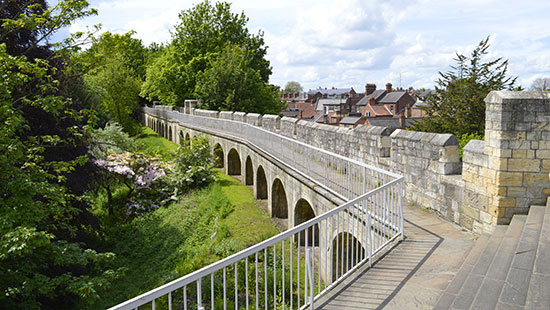
Discovering the Medieval Streets and History of York

February 03, 2017
5 minute read
When it rains, York has a mystical feel as if it were a town from Middle Earth. The dim streaks of light from lampposts reflect off the wet cobblestone streets and buildings dating back to Medieval York loom over.
Cobblestone streets and alleyways make up the historic heart of York. Besides being slippery, when wet, these roads bring out York’s ghostly feel. Some tourists even go as far as taking ‘haunted’ York travel tours, where visitors search for the specters roaming the alleyways and buildings.
I spent a week walking these streets in the spring with my sisters. Our group wasn’t particularly interested in finding any incorporeal beings. However, we were on the lookout for deals. While my sisters hunted for rare finds, antiques, and vintage clothing, I looked for old books. At a thrift store run by the RSPCA (Royal Society for the Prevention of Cruelty to Animals) on Gillygate, I came across a 1974 York Official Guide and Miniguide. Its retail price back in 1974 was 50 pence. I bought it for a pound.
Despite skepticism from my travelling companions, I used the guidebook to help me discover the history of the medieval streets of York. That guide (old treasure) is still relevant today; history doesn’t change, and the streets are the same as they were back in 1974. Apart from some old shops featured in the book that have been replaced by quirky new ones, little has changed.
Petergate and Stonegate

York’s streets are based on the original Roman street plan, developed and implemented when the Romans founded the city in 71 AD, according to the guidebook. The two main roads were Petergate and Stonegate.
What’s up with all these street names ending with -gate, you may ask?
According to the guidebook, while the Romans developed the street plan and built the Roman Wall, the Vikings used “-gate” in street names. Thus Petergate, Stonegate, Gillygate, Micklegate, Goodramgate and more. The medieval citizens left their timber-framed houses; the Georgians left the tall, elegant facades, and the Victorians left the red brick buildings with elabourate ornamentation.
Petergate or Via Principalis was and still is the main cross-street of old York. Petergate is divided into High Petergate and Low Petergate. High Petergate runs from Bootham Bar (a gate at the City Wall) to the end of Stonegate. From King’s Square on, the road becomes Low Petergate. Low Petergate is a narrow street dotted with half-timbered houses.
Stonegate or The Via Praetoria is from St. Helen’s Square to the Principia, where the Minster is located.
At the corner of High Petergate and Stonegate is Minerva, the Roman goddess of wisdom. She sits atop the corner of a building with an owl and rests on a pile of books. Years ago the street was filled with booksellers and bookbinders. A few bookstores are still located in the area.
The Shambles

The Shambles was known as the Fleshammels when it was a street filled with butcher shops. Today those butcher shops have been converted into restaurants, cafes, bookshops, boutiques and souvenir shops. The hooks and wooden shelves to display meat are still visible in most of these buildings.
The Shambles was often crowded when I was there, even when it was down pouring. It’s one of the best-preserved medieval streets in Europe. The street was designed to be narrow with overhanging buildings to provide shade and keep the meat from direct sunlight. Some of these overhanging buildings date back to the 14th-century.
My favourite place to hang out for tea and a meal was at Ye Old Shambles Tavern. It’s the best place to try pork pie with mushy peas and mint sauce. I chose to sit upstairs by the window to get a view of The Shambles and people walking down the street.
The Margaret Clitherow’s House on No. 35 is a chapel and historic house at The Shambles. Margaret Clitherow, a butcher’s wife, suffered a cruel death in 1586 for hiding Jesuit priests in her house.
Besides the captivating cobblestone streets and impressive historical buildings, York is home to the largest medieval church in England.
York Minster

York Minster towers over everything in York. It is located at the Roman Principia, the military headquarters of ancient York. York Minster is a British architectural wonder and historic icon. It has stained glass windows and houses many of England’s ancient artifacts.
York Minster started as a wooden church in about AD627 and the structure we see today was completed in 1240. Some of the highlights of York Minster for tourists include the medieval stained glass at the Great East Window and “Five Sisters” window, Undercroft, Central Tower, Nave, Chapter House, and the King’s Screen.
York’s City Walls

York's City Walls were built by the Romans in the second century. Back then the city’s borders were much smaller. Today Bootham Bar is the only medieval gate that sits on the Roman wall. The stone walls were extended during the Medieval times and were added on to over the centuries, mostly during the 13th century. There are five main gates (bars) and over 45 towers along the two-mile long York City Walls.
Apart from Bootham Bar (gate), you can find names like Monk Bar, Walmgate Bar, Fishergate Bar, Victoria Bar and Micklegate Bar.
It takes around two hours to walk the entire length of the wall.
To the Romans, York was Eboracum; the Saxons named it Eoforwic and the Vikings named it Jorvik. King George V once said: “The history of York is the history of England.”
Have you discovered York?
